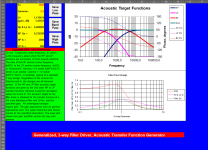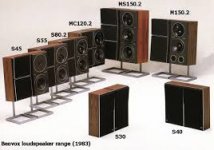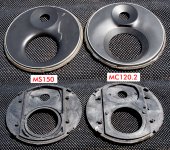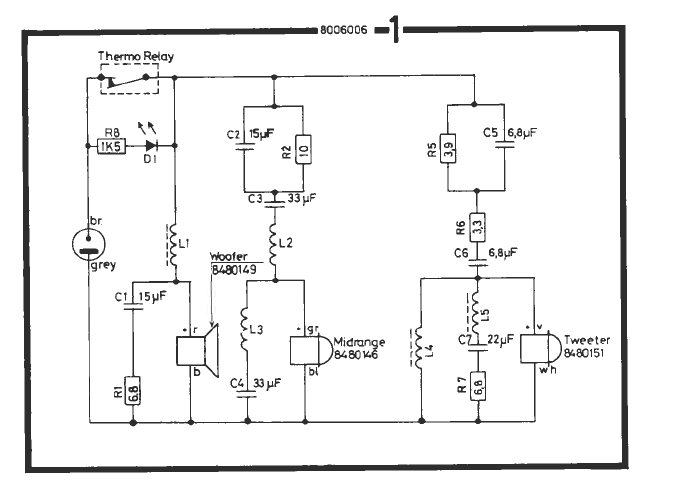Moving the driver rolloffs to 350hz/1.5kHz so that the mid and tweeter only follow the target highpass slopes for 1 octave before steepening to 3rd/4th order:
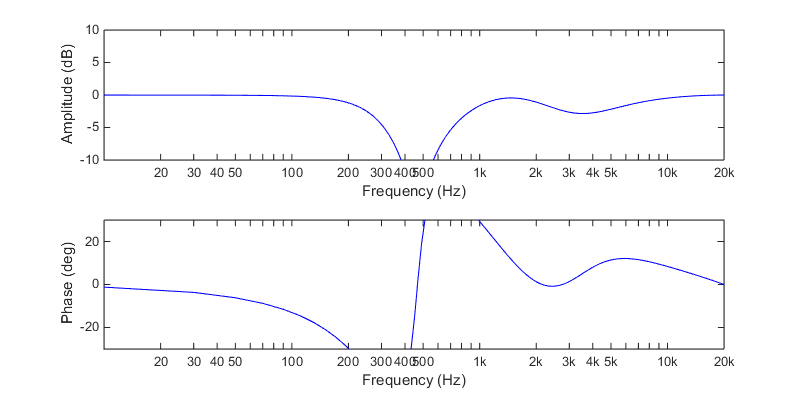
It would seem that hitting the target slopes for 1.5+ octaves is quite important.
edit: Back to the 200hz/1khz driver rolloffs, I was able to fix things a little by changing the woofer lowpass to BW2 1.2kHz and the mid lowpass to 5kHz.
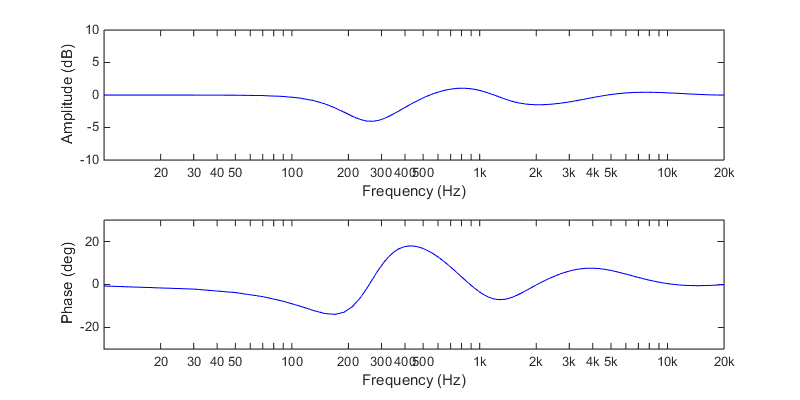

It would seem that hitting the target slopes for 1.5+ octaves is quite important.
edit: Back to the 200hz/1khz driver rolloffs, I was able to fix things a little by changing the woofer lowpass to BW2 1.2kHz and the mid lowpass to 5kHz.

Last edited:
TMM thanks sharing interesting post and nice visual data,
More to the subject was started by PLB at post 133 where some pdf files is available http://www.diyaudio.com/forums/multi-way/88135-filler-driver-ala-b-o-14.html#post4383549. Had a run PLB's filters (linked below) thru my JRiver DSP with soundcard hardwire loopback and REW listening in between at post 139 http://www.diyaudio.com/forums/multi-way/88135-filler-driver-ala-b-o-14.html#post4383814.
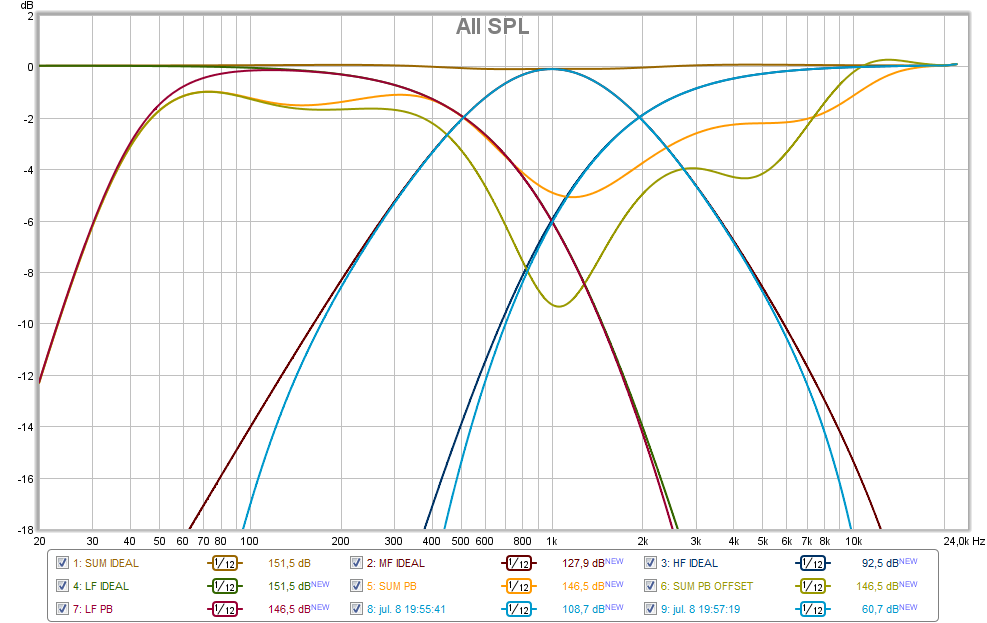
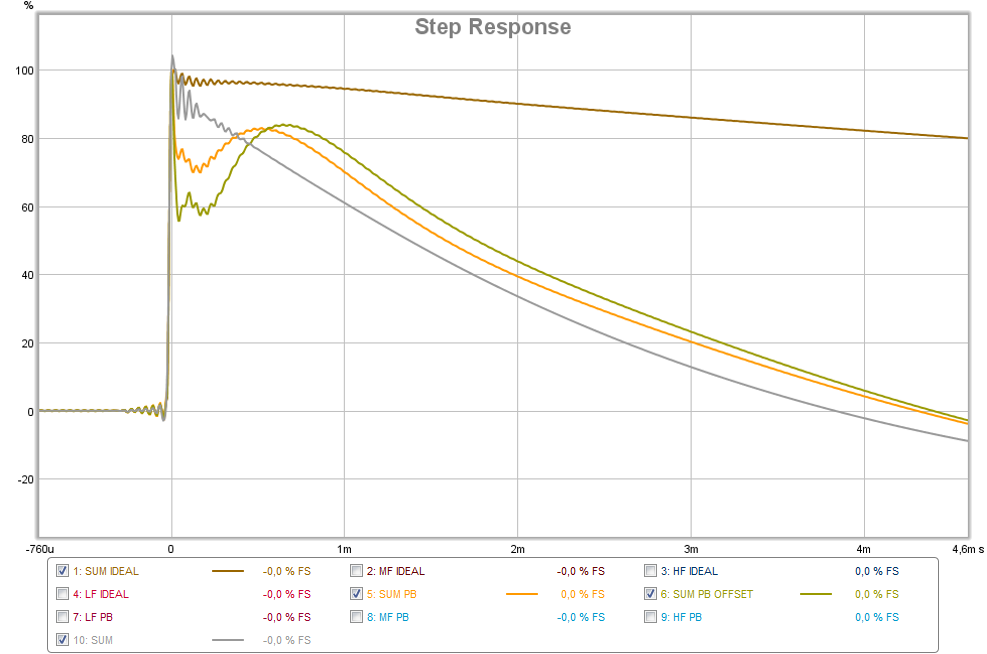
Guess key is use John Kreskosky's spreadsheet to find slopes that suit ones drivers bandwidth best, then from spreadsheet at the three grey button export the three curves as frd file and import into measurement program used as overlays and hit those slopes in acoustic domain, probably by a handful or more IIR filters as helpers and a way to bring acoustic center in sync. Below screen capture example from spreadsheet and at post 24 GM shared a link to spreadsheet http://www.diyaudio.com/forums/multi-way/88135-filler-driver-ala-b-o-3.html#post4375989.
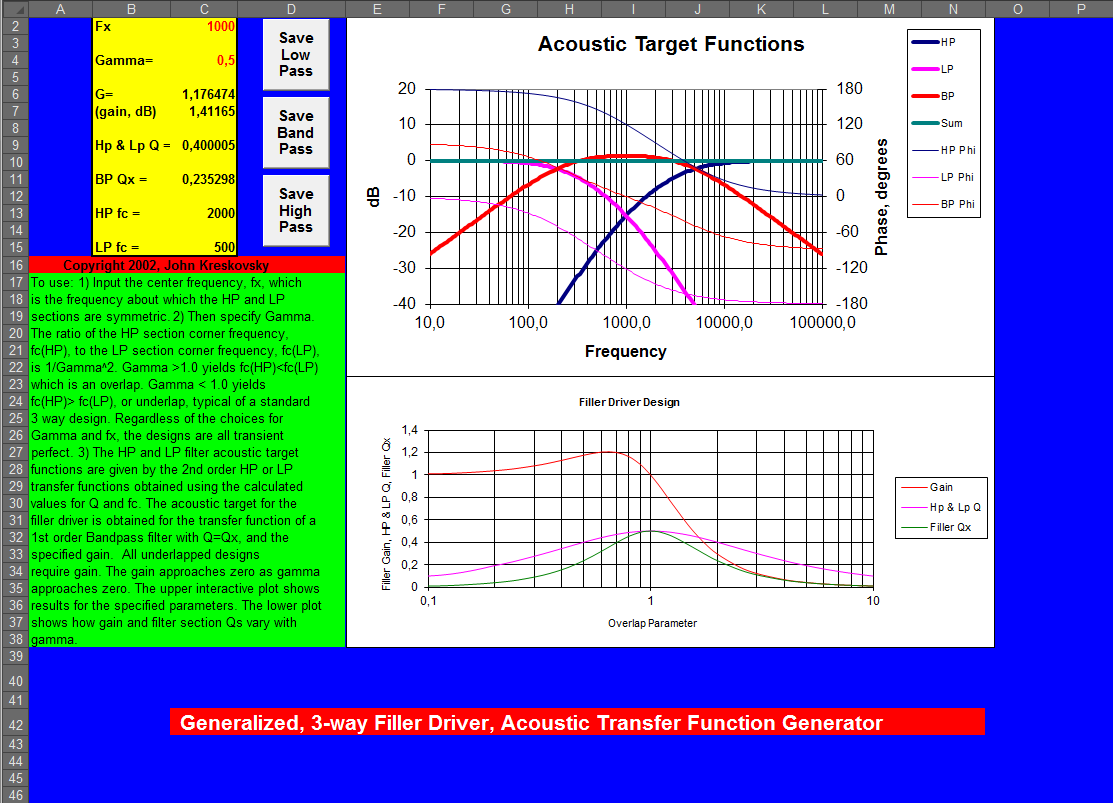
More to the subject was started by PLB at post 133 where some pdf files is available http://www.diyaudio.com/forums/multi-way/88135-filler-driver-ala-b-o-14.html#post4383549. Had a run PLB's filters (linked below) thru my JRiver DSP with soundcard hardwire loopback and REW listening in between at post 139 http://www.diyaudio.com/forums/multi-way/88135-filler-driver-ala-b-o-14.html#post4383814.


Guess key is use John Kreskosky's spreadsheet to find slopes that suit ones drivers bandwidth best, then from spreadsheet at the three grey button export the three curves as frd file and import into measurement program used as overlays and hit those slopes in acoustic domain, probably by a handful or more IIR filters as helpers and a way to bring acoustic center in sync. Below screen capture example from spreadsheet and at post 24 GM shared a link to spreadsheet http://www.diyaudio.com/forums/multi-way/88135-filler-driver-ala-b-o-3.html#post4375989.
Attachments
Has anyone tried a passive implementation using a ladder-delay network? Would be interesting to see that, but the complexity would be pretty staggering.
EDIT: meant a passive Harsch crossover, sorry.
EDIT: meant a passive Harsch crossover, sorry.
Has anyone tried a passive implementation using a ladder-delay network? Would be interesting to see that, but the complexity would be pretty staggering.
EDIT: meant a passive Harsch crossover, sorry.
I think the large value of the time delay requires a physical alignment of the tweeter position to be offset from woofer. If the delay were done passively and electronically the phase shift imposed by such a large all-pass network would negate any benefit one had for the transient perfect advantages. A stepped baffle is necessary. Hence speakers like Dunlavy are stepped baffle. I would imagine the only practical Harsch passive would be stepped baffle as well.
I would imagine the only practical Harsch passive would be stepped baffle as well.
..... or a two way with direct radiating woofer and a horn tweeter (like Econowave).
Regards
Charles
..... or a two way with direct radiating woofer and a horn tweeter (like Econowave).
Regards
Charles
SEAS DXT would be an interesting option to work with for a passive Harsch. Very robust tweeter that can handle LR2 acoustical at 1500Hz (first-order electrical), so the Harsch 2nd-order on the tweeter would not likely cause it to break into sweat.
I think I have found the perfect mid for use a hole filler driver. The Aurum Cantus AC130F1 (of Jeff Bagby's Continuum fame) measures flat from 100Hz to 10kHz, no breakup peaks. So with 2 octaves padding on either side will let me use it in a first order XO at 400Hz and 2.5kHz. It should be textbook perfect 1st order given how natively flat the response is. Here is a measurement in a sealed Hypercube (there is a 1.55kHz resonance from the enclosure that you can ignore).
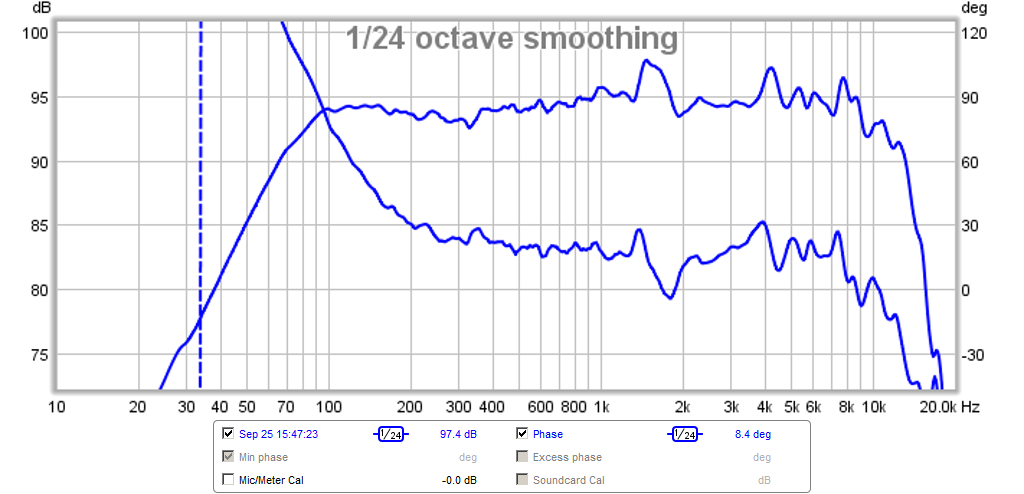
So I could revisit the B&O transient perfect hole filler with a good woofer XO with LR2 low pass at 400Hz, and a dome tweeter XO with LR2 high pass at 2.5Hz. Add the AC130F1 with BW 1st order on both sides at 400Hz and 2.5kHz. Should work splendidly. The 89dB sensitivity is a good match for my RC28F silk dome, and 96dB Beta12cx woofer.

So I could revisit the B&O transient perfect hole filler with a good woofer XO with LR2 low pass at 400Hz, and a dome tweeter XO with LR2 high pass at 2.5Hz. Add the AC130F1 with BW 1st order on both sides at 400Hz and 2.5kHz. Should work splendidly. The 89dB sensitivity is a good match for my RC28F silk dome, and 96dB Beta12cx woofer.
Reviving this old thread as I have some ideas for realizing this speaker. I believe the most critical driver here is the mid, it needs to be wide wide bandwidth and well behaved with no break up and with decent sensitivity. I think the Visaton B80 may be perfect for the wide band hole filler mid.
For woofer duties, the paper coned Dayton RS180P-8, very smooth, relatively high sensitivity, good xmax and made of paper to blend well with voice from B80.
For the tweeter, I will use the silk dome Dayton RS28F-4 which just arrived.
I want to make a passive speaker level crossover. So I guess LR2 acoustic transfer functions for woofer and tweeter with XO at 2kHz. B80 extends to 500Hz flat easily for 2 octaves on the left, and 8kHz easily for 2 octaves on the right with no breakup.
RS180P will have 12dB/oct falloff above 2kHz so should be OK and RS28F-4 has no problem with 2KHz LR2 high pass.
Here is RS180P-8 specs:
http://www.parts-express.com/pedocs...ference-paper-woofer-8-ohm-specifications.pdf
Here is RS28F-4 specs:
http://www.parts-express.com/pedocs/specs/275-140--dayton-audio-rs28f-4-specifications.pdf
The nice thing about Dayton RS drivers is that factory FRD and ZMA files are available to play with to get feel of how this can work, assuming mounted in a large IEC baffle.
One option vs the B80 is to go all Dayton and use RS100P-8 for the mid and is amde of same paper composition as the RS180P. I believe it may be able to cover the same range as the B80 actually.
RS100P-8 (the RS100P actually has slight edge over B80 on sensitivity):
http://www.parts-express.com/pedocs/specs/295-359s.pdf
Visaton B80:
http://www.visaton.com/pdfexport/de/servicestr.form?pid=/pdfexport/pdf/b80_8.html
Hmm...
I need to re-read this thread but do the drivers need to be on a stepped baffle for correct time alignment due to acoustic offsets?
I also have option of printing waveguides for both mid and tweeter to give them some setback and boost sensitivity (of mid if needed).
For woofer duties, the paper coned Dayton RS180P-8, very smooth, relatively high sensitivity, good xmax and made of paper to blend well with voice from B80.
For the tweeter, I will use the silk dome Dayton RS28F-4 which just arrived.
I want to make a passive speaker level crossover. So I guess LR2 acoustic transfer functions for woofer and tweeter with XO at 2kHz. B80 extends to 500Hz flat easily for 2 octaves on the left, and 8kHz easily for 2 octaves on the right with no breakup.
RS180P will have 12dB/oct falloff above 2kHz so should be OK and RS28F-4 has no problem with 2KHz LR2 high pass.
Here is RS180P-8 specs:
http://www.parts-express.com/pedocs...ference-paper-woofer-8-ohm-specifications.pdf
Here is RS28F-4 specs:
http://www.parts-express.com/pedocs/specs/275-140--dayton-audio-rs28f-4-specifications.pdf
The nice thing about Dayton RS drivers is that factory FRD and ZMA files are available to play with to get feel of how this can work, assuming mounted in a large IEC baffle.
One option vs the B80 is to go all Dayton and use RS100P-8 for the mid and is amde of same paper composition as the RS180P. I believe it may be able to cover the same range as the B80 actually.
RS100P-8 (the RS100P actually has slight edge over B80 on sensitivity):
http://www.parts-express.com/pedocs/specs/295-359s.pdf
Visaton B80:
http://www.visaton.com/pdfexport/de/servicestr.form?pid=/pdfexport/pdf/b80_8.html
Hmm...
I need to re-read this thread but do the drivers need to be on a stepped baffle for correct time alignment due to acoustic offsets?
I also have option of printing waveguides for both mid and tweeter to give them some setback and boost sensitivity (of mid if needed).
"I need to re-read this thread but do the drivers need to be on a stepped baffle for correct time alignment due to acoustic offsets?"
Yes.
Yes.
So I guess the first step is to measure all three in a flat baffle at the same vertical positions they will end up at to determine their acoustic offsets from the flat baffle plane. Then when simulating the XO, apply the offsets relative to a flat baffle to achieve time alignment in the simulation. From the new offset relative to the flat baffle offset, that tells me how much setback each driver needs relative to the woofer (assuming it is the zero setback baseline).
B&O used mid and high soft domes with Fs equalisation and time alignment by the look of it. Peerless foamed woofer I believe.[/QUOTE]
Hi. The B&O S45 which was the most popular of this range, had a cone midrange. The S45-2 and some of the S45 used rubber surround woofers.
I would suggest the Monacor msh 115 for the filler driver. It has a really flat FR up to 10k and a Fs of 85 Hz. Not too expensive either.
Hi. The B&O S45 which was the most popular of this range, had a cone midrange. The S45-2 and some of the S45 used rubber surround woofers.
I would suggest the Monacor msh 115 for the filler driver. It has a really flat FR up to 10k and a Fs of 85 Hz. Not too expensive either.
Is that a large coaxial on top for the S45? It looks like a mild angle canted angle is used to bring the woofer forward by tilting whole speaker backwards on a stand with tilt. Not a radical 3in offset as would have been required when I did a passive 2 way with transient perfect first order xo at 600Hz.
Here is the cone mid implementation S45-2:
The S45-2 uses 8in woofer and 3in mid and 1in dome very similar in size to drivers I am picking out. Maybe I am just making a modern version with updated readily available drivers?
https://www.beoworld.org/prod_details.asp?pid=666
An externally hosted image should be here but it was not working when we last tested it.
Here is the cone mid implementation S45-2:
An externally hosted image should be here but it was not working when we last tested it.
The S45-2 uses 8in woofer and 3in mid and 1in dome very similar in size to drivers I am picking out. Maybe I am just making a modern version with updated readily available drivers?
https://www.beoworld.org/prod_details.asp?pid=666
Last edited:
I need to 3D print one of those waveguide plates to hold the tweeter and mid together.
Does anyone have an actual XO diagram from one of these B&O hole filler speakers ?
I imagine it's
- 2nd order cap-coil LR2 HPF on tweeter
- 1st order coil and cap series BPF on mid
- 2nd order coil-cap LR2 LPF on woofer
Plus any notches, zobels, shelf, level match padding.
Does anyone have an actual XO diagram from one of these B&O hole filler speakers ?
I imagine it's
- 2nd order cap-coil LR2 HPF on tweeter
- 1st order coil and cap series BPF on mid
- 2nd order coil-cap LR2 LPF on woofer
Plus any notches, zobels, shelf, level match padding.
Last edited:
I think I have found the perfect mid for use a hole filler driver. The Aurum Cantus AC130F1 (of Jeff Bagby's Continuum fame) measures flat from 100Hz to 10kHz, no breakup peaks. So with 2 octaves padding on either side will let me use it in a first order XO at 400Hz and 2.5kHz. It should be textbook perfect 1st order given how natively flat the response is. Here is a measurement in a sealed Hypercube (there is a 1.55kHz resonance from the enclosure that you can ignore).

So I could revisit the B&O transient perfect hole filler with a good woofer XO with LR2 low pass at 400Hz, and a dome tweeter XO with LR2 high pass at 2.5Hz. Add the AC130F1 with BW 1st order on both sides at 400Hz and 2.5kHz. Should work splendidly. The 89dB sensitivity is a good match for my RC28F silk dome, and 96dB Beta12cx woofer.
Hi X, here is more accurate fr response for AC130F1. There is minor breakup at 5kHz. Otherwise its perfectly flat around 1-2kHz. There may be something wrong there with your setup.
Attachments
The top picture in #272 is I believe the later type 6427, which I seem to remember was a basic 2 way without the filler mid range, and so probably was not phase aligned(if that is the right term) It was considered a backward step by the enthusiasts of this design.
Hi X, here is more accurate fr response for AC130F1. There is minor breakup at 5kHz. Otherwise its perfectly flat around 1-2kHz. There may be something wrong there with your setup.
The 1.5kHz peak is due to the resonance of the hypercube enclosure (spherical breathing mode). It just happened to be the only enclosure I had at the time for a 5.25in sealed driver. I am pretty sure it is flat through there as shown by Zaph and factory curves.
schematic
At post 22 system7 is your friend here link http://www.diyaudio.com/forums/multi-way/88135-filler-driver-ala-b-o-3.html#post4375955
Ha ha post 23 says this:.....Does anyone have an actual XO diagram from one of these B&O hole filler speakers ?.....
Oh, wow! Thanks for B&O xo schematic! Really interested in this.
At post 22 system7 is your friend here link http://www.diyaudio.com/forums/multi-way/88135-filler-driver-ala-b-o-3.html#post4375955
- Status
- Not open for further replies.
- Home
- Loudspeakers
- Multi-Way
- "Filler" driver ala B&O
